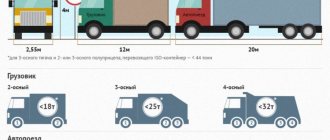According to the Ministry of Transport of the Russian Federation, in the total volume of cargo transported across the country using road transport, hazardous goods account for about 20%, that is, up to 1 billion tons are transported across Russia annually, and this figure is only growing. Every fifth kilogram of cargo belonging to the dangerous category is a lot; in most countries these figures are much more modest. But such a distribution can be understood, given how many hydrocarbons and other minerals, which are indirectly the source of exhaust gas production, are produced in our country.
How to transport dangerous goods correctly.
It is not surprising that the transportation of dangerous goods by road is subject to special requirements regulated at the legislative level. To carry out such activities, it is necessary not only to have a perfect knowledge of the relevant legal information, but also to comply with established requirements relating to all aspects of transportation of exhaust gas: personnel training, retrofitting of vehicles, preparation of a package of permits, correct labeling of cargo.
Failure to comply with any of the listed requirements threatens the carrier and the goods owner with the imposition of substantial fines, but the main danger is that people may suffer as a result of such actions. Irreversible or difficult to repair damage may be caused to the environment. We suggest you get acquainted with the peculiarities of transportation of exhaust gases and the requirements for participants in this process.
What is dangerous goods
Dangerous cargo is a substance that can harm the health and life of people, the environment and material assets in the event of an accident during its transportation.
The transport of dangerous goods is regulated by the European Agreement concerning the International Carriage of Dangerous Goods by Road (ADR or ADR).
The list of hazardous substances includes more than 3 thousand items. Each such substance has a special identification number. The list is divided into classes.
In Russia, the state standard GOST 19433-88 is in force, which divides dangerous goods into classes according to the level of danger. The requirements of this standard are developed in accordance with ADR.
What goods fall under the category of dangerous goods?
Substances of increased danger are those materials/products that, due to their physical and chemical characteristics, can pose a danger to nature and people during road transportation. Before a detailed consideration of the features of the transportation of dangerous goods by motor vehicles, we present their classification accepted in Russia.
Depending on the level of danger during road transport, the following classes of exhaust gases are distinguished (classification according to GOST 19435-88, based on the European agreement ADR):
- Class I – substances with the ability to ignite/explode, devices containing such substances/materials;
- Class II – gases (liquefied or in a compressed aggregate state, non-flammable/flammable, poisonous/toxic, chemically unstable);
- Class III – liquids (flammable or emitting flammable vapors);
- Class IV - solid flammable materials/substances (except those belonging to class 1) that have the ability to ignite during road transportation when exposed to external mechanical sources, when the substance absorbs moisture, heat, due to spontaneously starting chemical reactions;
- Class V - peroxides of organic origin or oxidizing materials/substances that have the ability to release oxygen (contributing to the maintenance of the combustion process), which, when interacting with other materials, can provoke an explosion or spontaneous combustion;
- Class VI – toxic/infectious materials/substances that can cause severe illness, intoxication of the body or lead to death upon contact with the epithelium or in the digestive tract;
- Class VII – radioactive products/materials/substances characterized by a radionuclide radiation intensity exceeding 70.0 kBq per kilogram;
- Class VIII - caustic liquids that, when exposed to exposed areas of the body, cause damage to the mucous membranes, epithelium, and respiratory tract. This class also includes corrosive materials that promote the active spread of corrosion upon contact with metal structures (acids, alkalis and similar substances);
- Class IX - substances that are not particularly dangerous during road transportation, but require careful handling in compliance with certain rules.
For the road transport of dangerous goods, vehicles must be equipped in accordance with a number of regulatory documents: ADR 2017/2018, the Motor Transport Charter, and the Rules for the Road Transport of Dangerous Goods.
Classes of dangerous goods
class 1 - explosive materials; class 2 - compressed, liquefied and dissolved gases under pressure; class 3 - flammable liquids; class 4 - flammable solids, spontaneously combustible substances, substances that emit flammable gases when interacting with water; class 5 - oxidizing substances and organic peroxides; class 6 - toxic substances and infectious substances; class 7 - radioactive materials; class 8 - caustic and (or) corrosive substances; class 9 - other hazardous substances.
Each class is also assigned a subclass, category and degree of danger. Not every carrier can transport these substances.
Check the organization's fines
Rules for the transportation of dangerous goods by road
Transportation of dangerous goods must be organized taking into account the requirements established by the following regulations:
- European Agreement concerning the International Carriage of Dangerous Goods by Road of September 30, 1957 (ADR);
- Federal Law of November 8, 2007 No. 257-FZ “On highways and road activities in the Russian Federation and on amendments to certain legislative acts of the Russian Federation”;
- Rules for the transportation of goods by road, approved. Decree of the Government of the Russian Federation dated April 15, 2011 No. 272;
- Rules for ensuring transportation safety, approved. by order of the Ministry of Transport of Russia dated January 15, 2014 No. 7;
- Order of the Ministry of Transport of the Russian Federation dated July 4, 2011 No. 179 “On approval of the Procedure for issuing a special permit for the movement of a vehicle transporting dangerous goods on roads.”
- High-risk cargo can only be transported with a special permit (more on this below).
- The vehicle must have a yellow or orange flashing light on.
- The vehicle must comply with the requirements of the Technical Regulations of the Customs Union “On the safety of wheeled vehicles” (TR CU 018/2011) and section 9 of ADR.
- Vehicles transporting hazardous substances are equipped with a “dangerous cargo” identification sign.
- The speed of movement must be established when agreeing on transportation.
- The driver must undergo special training and obtain a certificate of approval to transport dangerous goods.
- The carrier is obliged to comply with the precautions outlined in Chapter 1.10. ADR.
An example of a car's front and rear designation:
Special markings on the sides of tanks, as well as on the sides of vehicles and containers:
Requirements for ships when transporting dangerous goods
The transportation of exhaust gases by sea is regulated by another document - RID, which is also divided into hazard classes of substances and sets requirements for ships and personnel. The hazard classification corresponds to road transport standards.
The requirements for vessels are somewhat different; in order to carry out transportation, it is necessary to have an entry in the classified register certificate. The record contains information about the classes of substances available for transportation. In the absence of the necessary equipment on the ship, transportation is prohibited, but additional equipment of the transport is possible.
A gas carrier is a type of sea vessel designed to transport gas.
Before making an entry in the register, the ship administration must assess the readiness of the ship for transportation and designate the classes of substances. Then it is necessary to prepare the vessel for transportation. The preparatory stage includes:
- It is necessary to clean, wash and dry cargo areas;
- Check the condition of all components. The presence and serviceability of fire extinguishing and alarm systems, lighting gas analyzers, ventilation and drainage systems are checked;
- The entire crew is briefed on the features of exhaust gas and its transportation, the main types of hazards from cargo, packaging methods, and signage. The instruction also includes installation rules, increased precautions and first aid for poisoning and other exposure to harmful substances. Additionally, exercises are conducted to localize fires and emergency cargo deformations.
In case of all problems of the transporting ships and the integrity of the cargo, the captain bears full responsibility.
Documents required for the transport of dangerous goods
- special permit for the transportation of dangerous goods by road (for high-risk goods);
- certificate of vehicle approval for the transportation of dangerous goods;
- certificate of driver training for the transportation of dangerous goods;
- instructions for the driver, responsible persons, accompanying person on the rules of transportation;
- waybill with cargo markings;
- cargo safety data sheet;
- waybill;
- contract of carriage.
Checking fines for legal entities. persons
Try for free
Packaging labeling rules and vehicle designation requirements
First of all, the vehicle must meet all the above requirements, and, as a result, must have a permit for the transportation of dangerous goods, which is issued by the State Traffic Safety Inspectorate for a period of 1 year.
After the vehicle and driver have received the right to transport dangerous goods, the vehicle must be marked with appropriate markings so that all road users know that the vehicle is transporting dangerous goods, and the appropriate emergency response services in the event of an accident can quickly receive all the necessary information about the cargo and take all necessary measures to neutralize the consequences.
Therefore, the vehicle must be equipped with appropriate plates made of durable material that can withstand the active combustion phase for at least 15 minutes, while the inscriptions on it must also remain readable.
Such requirements are not accidental, because The entries on such plates contain information about the hazard class of the cargo and about the cargo itself: the hazard code is indicated in the upper part, and the cargo number according to the UN classification is indicated in the lower part. An example of such a plate is shown in the figure below.
You can find out more about the designation rules and decoding of all numbers and symbols on such plates in Chapter 5 of the ADR agreement.
In addition to the plate, the vehicle must also have an identification mark in the form of a diamond, which indicates the hazard class and subclass of the cargo being transported. If the posted danger signs are clearly visible on transported containers, tank containers, etc., then such a sign becomes optional.
In addition to all the above designations, marking of the container and packaging in which the dangerous goods are packaged is required. There are also a number of rules and requirements:
- marking must be reliable and durable;
- markings must correspond to the hazard class and subclass of the cargo;
- An additional sign is installed if the cargo poses a danger to the environment:
- A plate with information is installed on the container, which indicates the number of the dangerous goods according to the UN classification, and for classes 1,2,7, the number of the shipping name of the material (product).
Requirements for drivers to transport dangerous goods
To drive a car with dangerous cargo, the driver must complete a training course at a specialized training center and receive an ADR certificate of preparation for the carriage of dangerous goods of international standard.
The certificate contains information about exactly what hazard class the driver can transport. It depends on what training course you completed.
Training to transport hazardous substances can be completed by a driver with at least three years of continuous driving experience in the relevant category.
Without an ADR certificate, driving a vehicle to transport hazardous substances is prohibited.
Requirements for drivers - only experienced and responsible drivers are allowed
As a rule, carriers assign drivers with extensive experience to transport exhaust gases, who are additionally trained under special programs. During this training, employees learn:
- characteristics of materials and substances of great danger;
- special designations of containers for exhaust gases, markings and signs applied to the vehicle;
- procedure for action in case of accidents on the road (basics of disinfection, fire extinguishing, decontamination, degassing);
- rules for providing medical care to victims of dangerous goods;
- protocol for transmission and self-reporting of incidents en route.
Drivers transporting hazardous materials on a regular basis are required to undergo medical examinations every three years and express examinations before the trip. They also receive pre-trip special instruction on the specific types of dangerous goods they will be transporting. Drivers with less than three years of experience are not allowed to travel.
During the transportation of exhaust gas, the specialist driving the vehicle does not have the right to arbitrarily change the travel route, exceed the speed limit specified in the documents, not respond to warning and prohibition signs, or make stops in unapproved places. The driver takes the following documents with him on the road:
- a route sheet, in the upper left corner of which the number of the hazardous material according to the UN classification is written in red;
- license for a vehicle approved for transportation of exhaust gas;
- emergency card;
- transport bill of lading;
- permission to transport toxic substances;
- telephone numbers for contacting the responsible employees of the carrier company and the address of the cargo recipient.
Exhaust vehicle specialist
The driver is prohibited from transporting unauthorized persons and any products that are not included in the consignment note. If a car breaks down on the way, he needs to inform management about the stop location and immediately call a vehicle to provide technical support for the delivery of dangerous goods. The place where you have to stop should be fenced off and marked. For these purposes, a red flashing light and an emergency parking sign are used.
A driver driving a vehicle with hazardous materials does not have the right to:
- overtake and get ahead of cars traveling at speeds above 30 km/h;
- refuel at public gas stations;
- move away abruptly;
- smoke in the vehicle cabin and when inspecting the condition of transported goods;
- leave your car unattended;
- drive with the engine and clutch turned off.
If transport incidents occur along the way, the driver immediately reports this to his superiors and the traffic police, calls an emergency team, an ambulance if people are injured, and takes measures to eliminate the consequences of the incident. He is also obliged to fence off the accident site and not allow unauthorized persons into the car.
Requirements for a vehicle to transport dangerous goods
Dangerous goods can only be transported on special vehicles that are manufactured or retrofitted in accordance with regulatory documents.
You must also first obtain a certificate of approval of the vehicle for the transportation of hazardous substances.
On January 10, 2021, the updated regulations for issuing such a certificate came into force.
To obtain permission to drive a vehicle, you need:
- Contact the traffic police department with the following documents:
- statement;
- identification document of the applicant;
- power of attorney or agreement if the applicant is a representative of the owner of the vehicle;
- tank type approval certificate (for tanks);
- certificate of testing and (or) inspection of the tank indicating the list of substances approved for transportation (for tanks).
Until January 1, 2021, it is not necessary to present certificates for tanks (Resolution of the Government of the Russian Federation of March 16, 2021 No. 285).
- Provide the vehicle for visual inspection.
The official will check it for compliance with the requirements of the legislation of the Russian Federation, the requirements of ADR and the information specified in the documents.
- Receive a certificate of admission.
According to clause 20 of the regulations, the procedure should not take more than 3 hours.
There is no state duty or other payment, so obtaining permission to transport dangerous goods is free.
The issuance of a certificate may be refused on the basis of:
- unreliability of information in the submitted documents;
- lack of information about the passed technical inspection at EAISTO;
- failure to present the car for inspection;
- unauthorized changes to the vehicle design;
- discrepancies in vehicle markings (body number, engine number, etc.).
The certificate is valid for 6 months. In this case, the validity period of the certificate cannot exceed the validity period of the technical inspection.
For example. The technical inspection will expire in three months. The permit will also be issued for 3 months. If the next technical inspection is due in eight months, the permit will be valid for 6 months.
Requirements for containers for sea transportation
Prevention of severe burns, poisoning and other consequences of transportation or accidents mainly depends on the strength and tightness of the container. Each type of cargo has its own packaging requirements, which are described in RID. It is important that the container is able to withstand the usual motion sickness associated with sea transportation and the stress loads of an accident.
RID specifies the following types of container closures:
- Hermetic sealing - the packaging is vapor-tight, usually used when transporting vaporous substances;
- Effective closure - closure is able to contain liquid penetration in both directions;
- Reliable sealing - can protect against spillage, spillage and other effects of dry substances.
Materials used for packaging cargo must be inert towards exhaust gases. Also, the external coating should not enter into a destructive relationship with the external environment.
Each ship must have special cargo plans on board. They indicate the place where the exhaust gas is located, divided into sectors, the classification of the cargo, the type of container, the number of occupied spaces and the mass of the exhaust gas. Depending on the type of danger of the cargo, it is necessary to coordinate with the relevant services, which will determine the proper type of packaging and other transportation parameters.
Containers for the transportation of dangerous goods
The contents of the vessel should be packed tightly to enhance stability. An important condition is the presence of a proper level of ventilation of the cargo in general or each individual element. The stacking height is determined based on the strength of the packaging and is also entered into the cargo plan.
Permission to drive a vehicle with dangerous cargo
Transportation of dangerous goods classified as high-risk goods according to the European Agreement on the International Carriage of Dangerous Goods by Road (ADR) is permitted with a special permit (clause 1.1 of Article 31 of the Federal Law of November 8, 2007 N 257-FZ).
The list of high-risk cargo is presented in Table 1.10.5. ADR. Such cargo includes, for example:
- explosives and products (pyrotechnics, trinitrotoluene, hexogen);
- flammable liquids (acetone, gasoline, ethanol, kerosene, acids);
- flammable gases (oxygen, natural gas);
- liquid oxidizing agents (hydrogen peroxide, ammonium nitrate, potassium permanganate);
- toxic substances (carbamate-based pesticide);
- radioactive materials (products made from natural uranium, objects with surface radioactive contamination);
- corrosive substances (sulfuric acid, liquid acid batteries).
You can obtain permission to transport especially dangerous goods for a car that was previously included in the register of categorized vehicles of Rosavtodor (Article 31 of the Federal Law of November 8, 2007 N 257-FZ).
The procedure for issuing a special permit is established by Order of the Ministry of Transport of the Russian Federation dated July 4, 2011 No. 179. A permit is issued at the Rostransnadzor office at the place of registration of the applicant. You can send an application with copies of documents by mail or fill it out on the government services portal. A sample application is in Appendix No. 2 to the Order.
List of documents attached to the application:
- a copy of the STS or car rental agreement;
- a copy of the certificate of approval of the vehicle for the carriage of dangerous goods;
- a copy of the driver’s certificate of approval to transport dangerous goods;
- power of attorney, if it is not the owner of the vehicle who is applying, but his representative.
In addition, you need to provide a diagram of the transportation route with parking and gas stations. As well as information about the cargo being transported: name, description, class, UN number.
The authorized body verifies the completeness and accuracy of the information. Checks compliance of technical characteristics of transport with safety requirements.
As a result, the owners of the roads along which the route passes are sent an application for approval or the issuance of a permit is refused.
Reasons why a permit may be refused:
- the route does not pass along federal roads;
- non-compliance with the requirements of ADR to ensure the safety of transportation of dangerous goods;
- not all documents are presented or they are not reliable;
- There is no information about the inclusion of the vehicle in the register of categorized vehicles.
State duty in accordance with paragraph 111 of Art. 333.33 of the Tax Code of the Russian Federation will be 1300 rubles.
Compliance with the rules for the transportation of dangerous goods is monitored by the State Traffic Inspectorate and Rostransnadzor. Violators bear administrative liability.
Read more about ADR and innovations
The main document that regulates the transportation of dangerous goods by road is Government Decree No. 272 of 04/14/2011, which takes into account all the standards specified in the International Agreement on the Carriage of Dangerous Goods by Road (ADR). This agreement was first published back in 1968, but has been significantly modified several times. The version of ADR dated 2021 is currently in force.
The key rules regarding the transport of dangerous goods by road are the same as the rules regarding their delivery by rail. We are talking about emergency cards, markings, information plates and maps. The equipment of special transport includes:
- at least one wheel chock;
- two separate illuminated warning symbols;
- special uniform for crew members.
- The car must have a wear-resistant braking system with an analogue in case of an accident.
- For cars that weigh more than 16 tons, an anti-lock braking system is also a mandatory requirement.
- It is also necessary to establish a system of electrical circuit limiters, including so that the driver can disconnect the battery directly from his cab.
- Each car can have only one trailer, and you need to use a special bumper with a distance of 1 decimeter from its attachment to the tank.
In 2021, the Annexes to ADR were significantly revised. The following changes were recorded:
- Several other states signed the treaty.
- The conditions for transporting flammable substances in gas tanks, cylinders and containers are more clearly described. Capacity standards are specifically indicated.
- The list of terms denoting dangerous goods has increased to 3534 items.
- The use of containers made of soft materials is permitted with a number of reservations.
- The format of documents required for the legal transportation of dangerous goods has changed. Thus, from July 1, 2017, the use of the ADR directives of 2013 and 2015 is prohibited.
- New hazard symbols are now required for containers containing lithium batteries.
- Vehicles carrying exhaust gas were allowed to move through any tunnels.
- A number of amendments have been made to the process of conducting driving tests.
- Tanks for hydrogen peroxide and its solutions are prohibited for use.
- Chapter IX, Part 2 has been completely changed.
- The requirements for transporting lithium batteries have been corrected.
- Many innovations have affected the rules for using vehicles with internal combustion engines and equipment powered by lithium batteries for transporting exhaust gases.
Violations and fines for incorrect transportation of exhaust gases
As noted by traffic police officers, the most common violations in the field of transportation of dangerous goods are non-compliance of the vehicle design with the requirements and the lack of permits.
Liability for these violations and failure to comply with other requirements for the transportation of hazardous substances is established by Article 12.21.2 of the Administrative Code.
Responsibility is provided for the transportation of dangerous goods in the absence of:
- driver training certificates;
- vehicle approval certificates;
- special permission for transportation;
- emergency information card;
- compliance of the vehicle design with the requirements for the transit of dangerous goods;
- danger signs;
- emergency response equipment;
- conditions for the movement of hazardous substances;
Administrative fines in these cases are set in the following amounts:
- for drivers 2-2.5 thousand rubles or deprivation of rights for 4-6 months;
- for officials 15-20 thousand rubles;
- for legal entities 400-500 thousand rubles and detention of the vehicle.
For other violations, fines are imposed in the following amounts:
- for drivers 1-1.5 thousand rubles or deprivation of rights for 4-6 months;
- for officials 5-10 thousand rubles;
- for legal entities 150-200 thousand rubles.
Individual entrepreneurs bear administrative responsibility as officials.
For example, for the absence of an ADR certificate from an employee of an organization responsible for organizing transportation, the company will be liable in the amount of 150-200 thousand rubles, and the official himself will pay 5-10 thousand rubles.
Checking fines for legal entities. persons
Monitor fines, receive a daily report on new found fines and pay them automatically
Try for free
Rules for transporting exhaust gas in a column
When transporting dangerous cargo in a convoy, there are a number of rules:
- when the convoy leaves the loading site, each vehicle must have a fuel supply for 500 km of continuous movement;
- a person in the convoy must be appointed responsible for compliance with all standards and rules of transportation;
- in certain cases, the convoy must be accompanied by a traffic police vehicle, in which case the first vehicle drives with the flashing light turned on;
- in case of poor visibility (vision less than 300m), the convoy has the right to stop; this issue is described in more detail in the accompanying documentation and depends on the nature of the cargo and its hazard class;
- a forwarder accompanying the cargo must be present in the cabin;
- the distance between vehicles in a convoy must be more than 50 meters, and in poor visibility conditions - more than 300 meters.
Is it possible to pay a fine for dangerous goods at a discount?
Yes, the 50% discount is valid for 20 days from the date of delivery of the resolution. In order not to miss paying traffic fines, you can use a special service for monitoring fines for legal entities.
The service automatically monitors the appearance of new fines from the State Traffic Safety Inspectorate, MUGADN, AMPP, MADI, Platon in the state information system and sends notifications about payment deadlines with a discount. The service allows you to automatically upload fines to the organization’s accounting system and pay them from the company’s current account.
according to article
Write to our lawyer and he will help you understand automobile legislation. We will consider controversial situations and tell you how to act according to the law.
Don't miss new useful publications
We will tell you about the intricacies of the legislation, help you understand it and tell you what to do in controversial situations.









